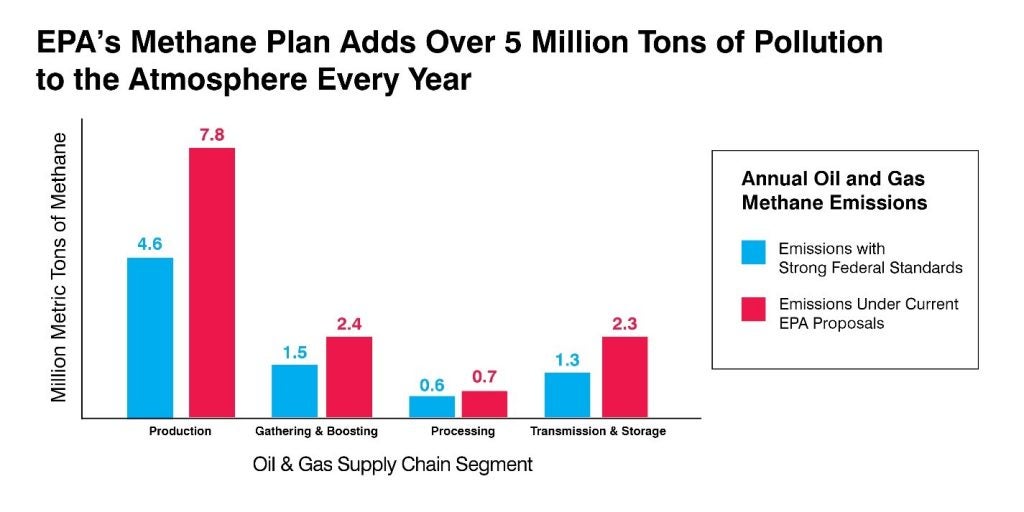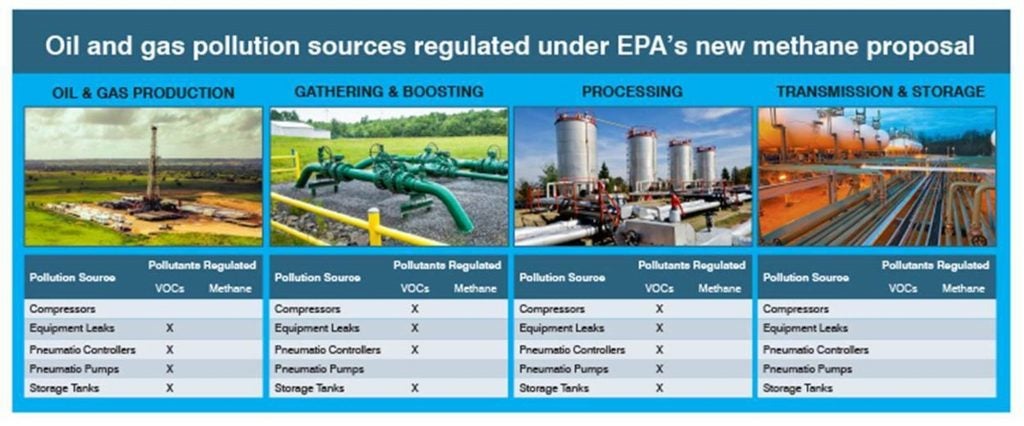EPA’s proposal to rollback methane rules ignores scientific evidence, will lead to 5 million tons of methane pollution
By Rosalie Winn and Jessica Christy
Last week, Environmental Protection Agency Administrator Andrew Wheeler proposed to entirely eliminate regulation of methane pollution from the oil and gas sector. He also proposed removing all federal regulation for both methane and harmful volatile organic compounds from pipelines and other midstream facilities.
The proposal is an attempt to prevent any federal oversight of pollution from more than 850,000 older oil and gas facilities across the country, while removing additional safeguards for new sources in major swaths of the oil and gas supply chain.
The proposal targets previous rules EPA adopted to address air pollution from oil and gas facilities built or updated after 2015. These “new source” rules include commonsense requirements to cut both methane and VOC emissions across the upstream (production, gathering and boosting, and processing) and midstream (transmission and storage) segments of the oil and gas supply chain. While companies have been complying with these policies for years, the current proposal seeks to:
- Eliminate all methane standards across the oil and gas supply chain.
- Exempt facilities in the transmission and storage segment from any federal standards.
- Prevent any future regulation of pollution from “existing” sources built before 2015.
The proposal comes on the heels of a separate EPA proposal that significantly decreases company obligation to check for methane and other dangerous pollution.
If EPA is successful in adopting both proposals, it would result in an additional 5 million metric tons of preventable methane pollution annually — more than a third of total emissions from the oil and gas industry. That lost gas is enough to heat 4 million homes. Despite this massive climate pollution, EPA’s air chief Anne Idsal claims she doesn’t “see that there’s going to be some big climate concern here.”
Notably, a number of major oil and gas companies support regulating methane in the oil and gas sector. Companies like BP and Shell have made statements reaffirming their explicit support for federal methane standards in the face of the Trump administration’s misguided proposal.
EPA's proposal to rollback methane rules ignores scientific evidence, will lead to 5 million tons of methane pollution Share on XEPA’s flawed reasoning
EPA’s proposal advances two flawed legal theories for removing methane regulations for the oil and gas industry.
First, EPA claims methane regulations are entirely redundant of VOC regulations because the technologies and practices in the current new source standards reduce both methane and VOCs. But this rationale fails to consider the hundreds of thousands of existing sources, built before 2015, that wouldn’t be required to reduce either pollutant under the legal theory advanced by EPA in this proposal, as discussed below.
Second, EPA is weighing shirking its responsibilities under the Clean Air Act. Before EPA can regulate an industry, the agency must first prove it produces air pollution that endangers public health or welfare. Under the plain language of the act and EPA’s longstanding interpretation, once EPA identifies a pollution source it does not need to make additional endangerment findings each time it regulates additional pollutants emitted by a listed source category (the agency does need to explain its rationale for regulating new pollutants, which it did in extensive detail in 2016).
EPA is now considering disregarding the statute and reversing that longstanding notion by requiring endangerment and significant contribution findings that are specific to both the pollutant as well as the source category.
Moreover, EPA did make these exact findings in the 2016 rule based on overwhelming record evidence, and the evidence could not support a contrary finding. EPA’s proposal ignores the clear science showing that oil and gas methane pollution is a large contributor to climate change and a significant source of potent methane pollution in the United States.
For example, an extensive, peer reviewed scientific study found the U.S. oil and gas industry emits over 13 million metric tons of methane pollution every year — 60% more than EPA estimates suggest.
The agency’s proposal disregards this overwhelming body of scientific evidence, instead spending countless pages discussing arcane issues of statutory interpretation in an effort to obscure what the underlying factual record makes plain: methane from the oil and gas sector is a harmful air pollutant that must be regulated under our nation’s clean air laws.
Removing all standards for transmission and storage sources
In addition to removing methane regulation across the oil and gas supply chain, EPA seeks to exempt midstream transmission and storage facilities from complying with the Clean Air Act. EPA argues that transmission and storage sources are too different from production and processing facilities, and therefore should not be regulated in the same category. The argument is undermined by the extensive overlap between the types of equipment, control requirements and pollution reductions across these sources that are within the same sector.
An attempt to prevent existing source regulation
EPA also argues that eliminating methane regulations from new oil and gas facilities removes the agency’s legal obligation to address pollution from existing sources too. Remarkably, EPA claims (without any supporting analysis) there will be no significant harm from pollution from existing sources because voluntary actions, state regulations and equipment turnover will address the problem.
These arguments ignore that voluntary programs and state standards for existing sources only cover a fraction of the many existing sources across the country. For example, of the thousands of oil and gas companies across America, only about 1% participate in voluntary programs to address methane emissions (and, as noted below, some of these very companies recognize that voluntary efforts are not enough to address the problem). Additionally, state regulations only overlap with about 5% of the methane pollution that could be reduced by federal rules applied to existing sources.
Fundamentally, the Clean Air Act was specifically designed to provide uniform federal standards for dangerous pollutants like methane. None of the laundry list of arguments advanced by EPA are permissible reasons under the act to dodge the agency’s legal obligation to protect our air from dangerous oil and gas pollution.
The net result of EPA’s actions: millions of tons of additional pollution
EPA acknowledges that deregulating new and modified sources in the transmission and storage segment will create 340,000 metric tons of methane, 9,100 metric tons of VOCs, and 270 metric tons of hazardous air pollutants from 2019-2025 from these sources.
But EPA failed to likewise assess the impacts of completely ignoring pollution from existing oil and gas sources. Based on 2017 data and the latest peer-reviewed estimates of oil and gas methane emissions, EDF estimates that if the administration successfully finalizes its two proposals, the net result would be 5 million metric tons of methane (3.8 million from existing sources alone), 1.2 million tons of smog-forming VOCs, and over 43,000 tons of hazardous air pollutants like cancer-causing benzene that would otherwise be prevented each year.
Leading companies call for methane regulation
Shell, BP, and ExxonMobil support federal rules for methane and even asked EPA to extend them to existing sources. As BP wrote, companies should realize federal rules keep methane pollution across the whole industry in check and “voluntary actions by several energy companies are not enough to solve the problem.”
Companies face increasing pressure from investors to support smart methane policies. Investors recognize that weak federal standards threaten natural gas’s reputation in a clean energy future. Strong methane regulations are needed to provide protections for all Americans and a baseline, level playing field for all in the industry.
EPA’s proposal ignores basic pollution facts and undermines the agency’s legal responsibility to protect our health and our environment. Over the next two months, EPA will be accepting public comments on the proposal. Now is the time for all stakeholders — including state and local governments, community and public health organizations and companies alike — to step up in opposition to EPA’s deeply harmful proposal.
Jessica Christy is an attorney.












